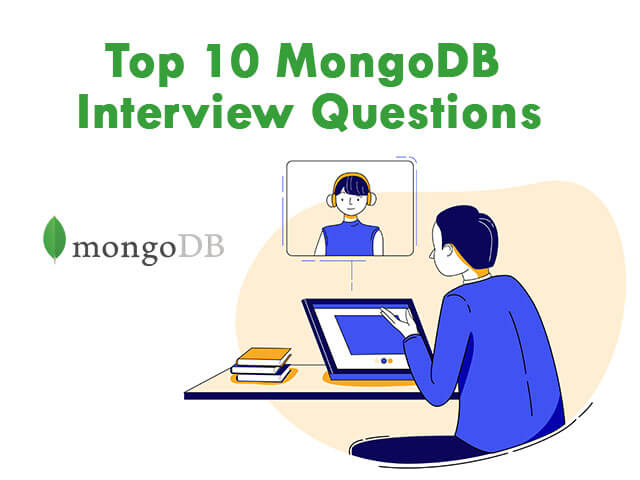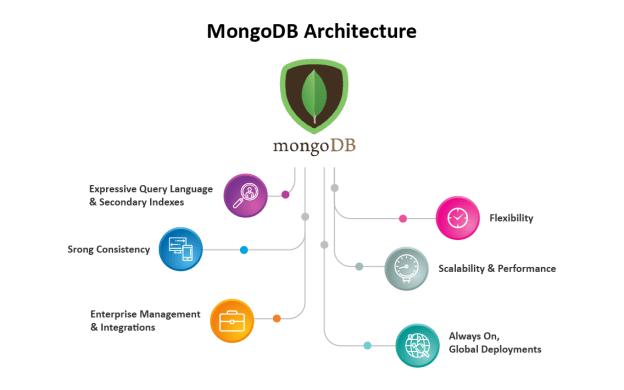Are you looking out to enhance your career in databases? If yes, then a MongoDB certification course might interest you!
Popular as a document-oriented NoSQL database, MongoDB finds use in high volume data storage. What makes it stand out from the conventional relational databases is that MongoDB features collections and documents instead of rows and columns. MongoDB’s basic unit of data is the key-value pairs that make up the documents. On the other hand, collections comprise sets of functions and documents, making them equivalent to relational databases’ tables. With a host of unique features, including scalability and flexibility, MongoDB is the number one choice for working with databases.
Top 10 MongoDB Interview Questions

Are you not convinced? Then read on to know more about why you should learn MongoDB and take a MongoDB certification course. We’ve also listed the top 10 most frequently asked questions in MongoDB interviews.
Why learn MongoDB?
More and more companies and database developers turn towards a robust database system that offers top-notch features besides being highly flexible and scalable. In this race for popularity, MongoDB has left behind other market competitors like Or{“type”:”block”,”srcClientIds”:[“96f6da7a-b718-4204-82e7-8a326ce18fa4″],”srcRootClientId”:””}acle and Couchbase to emerge as the leader of the pack.

But, what makes MongoDB so unique? And, is a MongoDB certification course worth your time? Well, the following points may give you some food for thought:
- MongoDB is future-proof and flexible. You can do away with the limitations of using a rigid database system because MongoDB will let you work with new data structures at your convenience.
- MongoDB works on a serverless platform (known as Stitch), which proves its immense flexibility. Hence, you don’t need to worry about web hosting or application services.
- You can seamlessly develop and deploy MongoDB in the cloud. Its SaaS version that goes by the name of ‘Atlas’ makes this possible.
- MongoDB meets all the complex requirements of modern app development. While its document-oriented model can achieve complicated tasks, it is comparatively easy to learn.
- MongoDB is a time-tested database used and trusted by some of the most elite companies worldwide, including Google, Adobe, eBay, and Business Insider. So, learning MongoDB will definitely improve your marketability.
- Last but not least, MongoDB comes at no cost! It is free to use and is transparent enough to let developers make modifications as and when needed.

Top 10 MongoDB interview questions
An increasing number of companies are adopting this gem of software called MongoDB. So, if you are a database developer or a budding one, then here is a list of the most trending questions that you will most likely encounter in any intervie concerned with this field:
1. What are NoSQL databases? Give some examples.
NoSQL databases are unlike traditional or relational database management systems and can handle and sort all types of unstructured and complicated data. Widely noted for their functionality, ease of development, and scalability, NoSQL databases are specifically optimized for applications that require flexible data models, large data volumes, and low latency.
Prominent examples of NoSQL databases include MongoDB, CouchDB, Cassandra, Redis, Couchbase, Voldemort, Neo4j, Riak, Hypertable, HBASE, MemcacheDB, etc.
2. What are the different programming languages that MongoDB supports?
MongoDB gives official driver support for the following languages: Java, C, C++, C#, Perl, Node.js, Ruby, Python, Scala, Erlang, and Go.
3. What are the various types of NoSQL databases?
NoSQL databases are classified into the following four types:
- Key-value databases
- Document databases
- Graph databases
- Column-oriented databases
4. What are the core features of MongoDB?
The key features of MongoDB that make it one of the best in the market include:
- Document-oriented with robust performance
- Automatic and easily scaling
- Rich query language
- High availability
5. Explain the concept of ‘sharding’ in MongoDB.
Sharding is the process of distributing data across multiple machines. This feature of MongoDB meets the demand for data growth by horizontal partitioning of data in a search engine or database. Each of such partitions is known as a shard.
6. What is meant by ‘replica set’ in MongoDB?
In MongoDB, a replica set is a set of mongo instances hosting the same dataset. In such a replica set, one node is the primary one, and the other is secondary. All data replicates from the primary node to the secondary one.
7. What is the function of GridFS in MongoDB?
GridFS is a particular specification in MongoDB for the storage and retrieval of files exceeding the BSON document size limit of 16MB. This grid functions by dividing a file into smaller parts and storing each of the parts as a discrete document instead of saving them as a single one.
8. Which command in MongoDB provides information on all the query plans?
In MongoDB, the explain() command provides information on all the query plans. The possible models include the following:
- ‘queryPlanner’,
- ‘executionStats’
- ‘allPlansExecution’
9. How many master servers does MongoDB allow? And, which syntax will tell you if you are on the master server?
MongoDB allows one master server only. The syntax Db.isMaster() tells if we are on the master server or not.
10. What is meant by ‘index’ in MongoDB? And, what is the basic syntax to use an index?
An index is a particular structure in MongoDB for efficient query execution. It stores a small segment of the dataset in a form that is easily traversable. Without the indexes, MongoDB would have to do a collection scan of every document to select the ones satisfying the query statement.
The basic syntax for using the MongoDB index is: >db.COLLECTION_NAME.ensureIndex ( {KEY:1} ). In this syntax, the ‘key’ refers to the name of the column (or key-value pair) that is present in the documents.
So, what are you waiting for? Buckle up and take the MongoDB certification course to open up new opportunities towards a promising career besides enhancing your database skills. MongoDB certified professionals are in great demand for their knowledge and expertise in using MongoDB in practical applications. A MongoDB certification is a significant addition to your resume that will help you stand out from the lot when applying to organizations that have implemented MongoDB or are planning to do so.
Quiz Question about MongoDB
Q. For what purpose MongoDB go to use?
Ans: To manage ustructured data like log or loT, generally MongoDB NoSQL database go to use which is the open source database.
Q. Explain any four advantages of MongoDB?
Ans: 1. MongoDB database is so much easy to scale up or down 2. Generally MongoDB supports primary and secondary index on any fields 3. There is a inbuilt support for data partitioning in MongoDB database. 4. Usually MongoDB uses JavaScript objects in a place of procedures.
Q. What are the names of reserved Database in MongoDB?
Ans: local, admin, config.
Q. Which kind of Database MongoDB?By which language it has been written?
Ans: MongoDB is a NoSQL database and it has written in C++ language.
Q. Give the name of some attractive features of MongoDB database?
Ans: 1. File Storage 2. Indexing 3. Sharding 4. Aggregation 5. File Collection 6. Index Type
Q. Give some examples of questions related with MongoDB, which go to ask during the interview?
Ans: 1. Explain the term ‘Indexing’ in MongoDB 2. Explain the process of Sharding 3. How to perform queries in MongoDB? 4. How to add data in MongoDB? 5. What is a document in MongoDB? 6. What is the Mongo Shell? 7. What are the data types in MongoDB? 8. Explain the SET Modifier in MongoDB? Etc.
